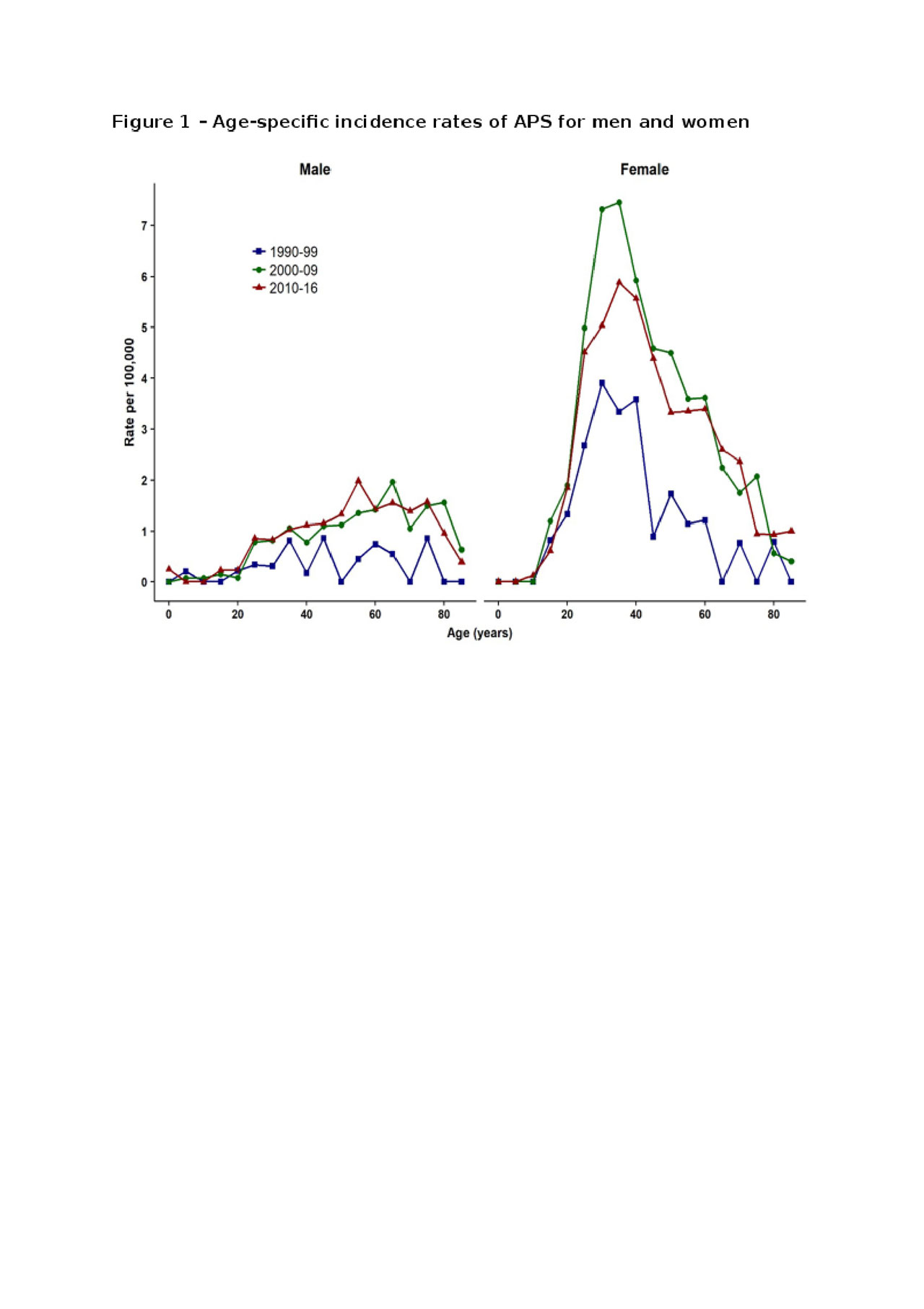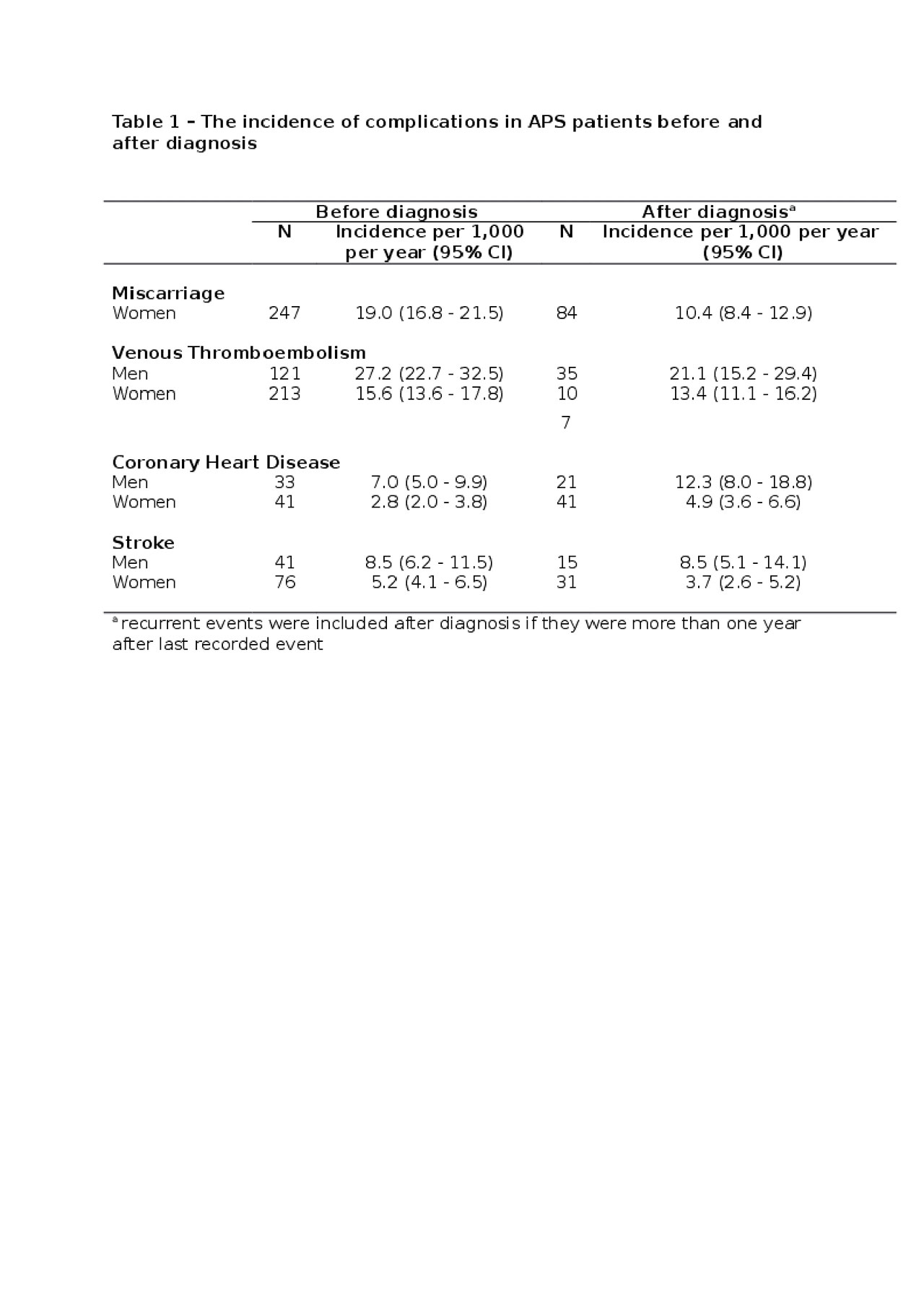Session Information
Session Type: ACR Abstract Session
Session Time: 2:30PM-4:00PM
Background/Purpose: Antiphospholipid syndrome (APS) is a systemic autoimmune disorder characterised by recurrent vascular thrombosis and/or pregnancy morbidity in the presence of persistently positive antiphospholipid autoantibodies. It is estimated to account for 6% of all pregnancy morbidity, 13.5% of stroke, 11% of myocardial infarction and 9.5% of all deep vein thromboses. One small population-based study of APS has been reported and included only 33 individuals. This study aimed to estimate the incidence of APS and its complications in a large UK population.
Methods: A cohort study was conducted using the UK Clinical Practice Research Datalink. This is a database of primary care records kept by general practitioners in the National Health Service. It is deemed to be generally representative and contains active records for around 7% of the UK population. Data for all recorded cases of APS were included in this study. The incidence and prevalence of APS in the general population and the occurrence of venous thromboembolism (VTE), coronary heart disease (CHD), stroke and miscarriage in APS patients were estimated. The standardised mortality ratio was calculated to compare the mortality of APS patients to that of the UK general population.
Results: Data were analysed for 2,606 participants recorded with APS. In women, a peak incidence of 7.5 (95% confidence interval (CI) 6.2 to 8.9) APS cases per 100,000 person-years was observed at 35-39 years; in men, incidence reached a maximum of 2.2 (95% CI 1.2 – 3.5) per 100,000 at 55 to 59 years. Prevalence peaked at 50 (95% CI 49 – 55) in females in 2011 and 9.8 (95% CI 8.6 – 11.1) per 100,000 in males in 2012. Overall female to male ratio was 4:1. Before diagnosis, APS patients showed elevated incidence of miscarriage (19.0); VTE (men 27.2; women 15.6); CHD (men 7.0; women 2.8); and stroke (men 8.5; women 5.2) per 1,000 per year. The rate of miscarriage was lower after APS diagnosis (10.4 per 1,000 per year, 95% CI 8.4 – 12.9). There was no significant change in the rate of thrombotic complications after APS diagnosis. SLE was found in 20% of APS cases (SLE-APS). Female to male ratio was higher in this group compared to APS patients without SLE (10:1 and 4:1, respectively) and there was no significant difference in the rate of miscarriage or thrombotic manifestations. The overall standardised mortality ratio was 1.49 and 1.33 in females and males respectively.
Conclusion: This is the largest cohort of APS patients published to date. The overall estimated incidence is 1.8 and point prevalence of 43 per 100,000 persons in 2015. APS patients have elevated rates of thromboses, miscarriage and death compared to the general population.
To cite this abstract in AMA style:
Rodziewicz M, D'Cruz D, Gulliford M, Hazra N. The Epidemiology of the Antiphospholipid Syndrome in the UK, 1990 – 2016 [abstract]. Arthritis Rheumatol. 2019; 71 (suppl 10). https://acrabstracts.org/abstract/the-epidemiology-of-the-antiphospholipid-syndrome-in-the-uk-1990-2016/. Accessed .« Back to 2019 ACR/ARP Annual Meeting
ACR Meeting Abstracts - https://acrabstracts.org/abstract/the-epidemiology-of-the-antiphospholipid-syndrome-in-the-uk-1990-2016/


